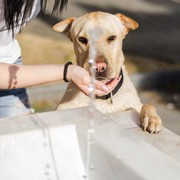
Some of us take the phrase, “dog days of summer” quite literally— we want to go everywhere accompanied by our beloved dogs! While this can be great, know that the heat of summer has the potential to be hazardous to your dog’s health. One of the greatest summer dangers is dehydration. Dogs get hot faster than people, and it’s easy for even the healthiest of dogs to become dehydrated.
Significant forethought and planning to accommodate higher temperatures separate a fun summer day from a trip to the emergency veterinarian.
What exactly is dehydration in dogs?
Dehydration refers to a shortage of water within the body. Do you know that approximately 60% of your dog’s body mass is comprised of water? Not only is water a component of what flows within blood vessels (arteries and veins), water is also an essential component within cells and the tissues surrounding them. Given its ubiquitous nature, it’s easy to understand why having an adequate amount of water within the body is essential for maintaining normal blood pressure, circulation, and bodily functions.
Causes of dehydration in dogs
Dehydration results when too little water is consumed in relationship to the amount lost from the body. For example, a dog who is sick with vomiting or diarrhea and doesn't feel good enough to drink lots of water to make up for these fluid losses can readily become dehydrated. Kidney disease can cause dehydration because the damaged kidneys produce abundant urine regardless of how little water is consumed.
Summertime heat promotes dehydration, particularly when a dog isn’t interested in or doesn’t have access to lots of water. Think about the tennis ball obsessed dog who doesn’t like to interrupt a good game of fetch to gulp down some water. Whereas this may not be a problem in cooler temperatures, water loss associated with heavy summertime panting can quickly result in dehydration.
Detecting dehydration in dogs
Dehydration causes a variety of symptoms and dogs may demonstrate from one to all of them. Symptoms include:
- Lethargy
- Weakness
- Labored breathing
- Elevated heart rate
- Dry and sticky feeling gums (normal gums are slick and smooth to the touch).
If you suspect your dog may be suffering from dehydration, do your best to find some shade or an air conditioned environment and encourage drinking. If the symptoms don’t improve within a short time period (five minutes at most), it’s time to seek out emergency veterinary care.
Preventing dehydration in dogs
Here are some pointers to keep your favorite Fido well hydrated this summer:
- Exercise your dog early in the morning or evening hours to avoid the most intense heat of the day.
- Be sure to take along water and a water bowl (one that is familiar to your dog) wherever you go. Don’t rely on natural water sources being available.
- Allow for plenty of rest and water breaks during play activity and exercise. Your dog may not know his limits and will continue to enthusiastically chase the Frisbee long after it’s time to slow down.
- Provide water access frequently. When out in the heat, be sure to provide a water stop (for you and your dog) at least once every 15 to 20 minutes.
- If your dog is preoccupied with something else (other dogs, a tennis ball, etc) or too excited to drink, best to cut your outing short for the sake of preventing dehydration.
As much as we love to bring our dogs with us everywhere, be reminded that, when temperatures are soaring, your dog’s well being may be best served by being left at home.
If you have any questions or concerns, you should always visit or call your veterinarian – they are your best resource to ensure the health and well-being of your pets.
